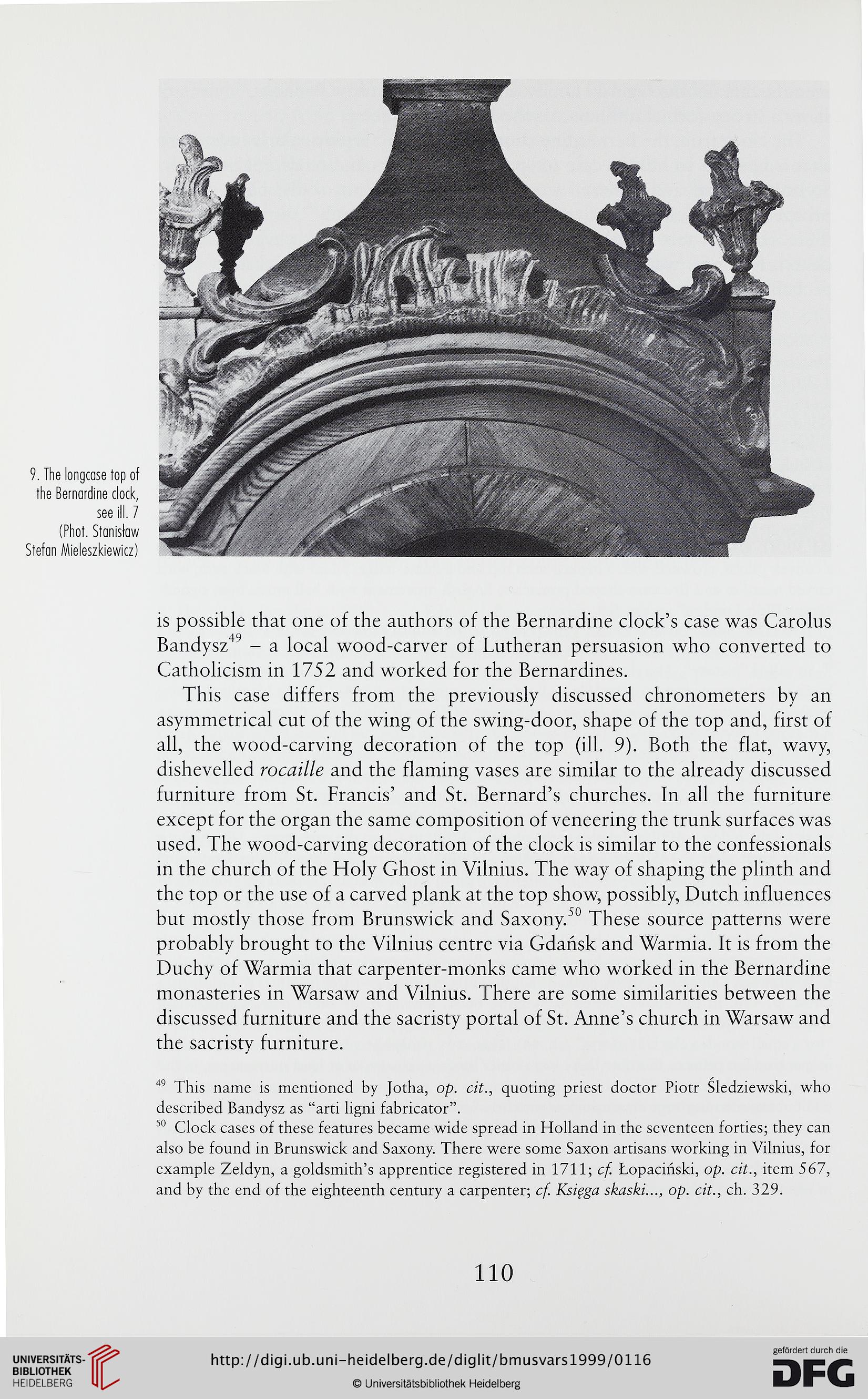9. The longcase top of
the Bernardine clock,
see ill. 7
(Phot. Stanisław
Stefan Mieleszkiewicz)
is possible that one of the authors of the Bernardine clock’s case was Carolus
Bandysz4’ - a local wood-carver of Lutheran persuasion who converted to
Catholicism in 1752 and worked for the Bernardines.
This case differs from the previously discussed chronometers by an
asymmetrical cut of the wing of the swing-door, shape of the top and, first of
all, the wood-carving decoration of the top (ill. 9). Both the fiat, wavy,
dishevelled rocaille and the flaming vases are similar to the already discussed
furniture from St. Francis’ and St. Bernard’s churches. In all the furniture
except for the organ the same composition of veneering the trunk surfaces was
used. The wood-carving decoration of the clock is similar to the confessionals
in the church of the Holy Ghost in Vilnius. The way of shaping the plinth and
the top or the use of a carved plank at the top show, possibly, Dutch influences
but mostly those from Brunswick and Saxony.49 50 These source patterns were
probably brought to the Vilnius centre via Gdańsk and Warmia. It is from the
Duchy of Warmia that carpenter-monks came who worked in the Bernardine
monasteries in Warsaw and Vilnius. There are some similarities between the
discussed furniture and the sacristy portal of St. Anne’s church in Warsaw and
the sacristy furniture.
49 This name is mentioned by Jotha, op. cit., ąuoting priest doctor Piotr Śłedziewski, who
described Bandysz as “arti ligni fabricator”.
50 Clock cases of these features became wide spread in Holland in the seventeen forties; they can
also be found in Brunswick and Saxony. There were some Saxon artisans working in Vilnius, for
example Zeldyn, a goldsmitfPs apprentice registered in 1711; cf. Łopaciński, op. cit., item 567,
and by the end of the eighteenth century a carpenter; cf. Księga skaski..., op. cit., ch. 329.
110
the Bernardine clock,
see ill. 7
(Phot. Stanisław
Stefan Mieleszkiewicz)
is possible that one of the authors of the Bernardine clock’s case was Carolus
Bandysz4’ - a local wood-carver of Lutheran persuasion who converted to
Catholicism in 1752 and worked for the Bernardines.
This case differs from the previously discussed chronometers by an
asymmetrical cut of the wing of the swing-door, shape of the top and, first of
all, the wood-carving decoration of the top (ill. 9). Both the fiat, wavy,
dishevelled rocaille and the flaming vases are similar to the already discussed
furniture from St. Francis’ and St. Bernard’s churches. In all the furniture
except for the organ the same composition of veneering the trunk surfaces was
used. The wood-carving decoration of the clock is similar to the confessionals
in the church of the Holy Ghost in Vilnius. The way of shaping the plinth and
the top or the use of a carved plank at the top show, possibly, Dutch influences
but mostly those from Brunswick and Saxony.49 50 These source patterns were
probably brought to the Vilnius centre via Gdańsk and Warmia. It is from the
Duchy of Warmia that carpenter-monks came who worked in the Bernardine
monasteries in Warsaw and Vilnius. There are some similarities between the
discussed furniture and the sacristy portal of St. Anne’s church in Warsaw and
the sacristy furniture.
49 This name is mentioned by Jotha, op. cit., ąuoting priest doctor Piotr Śłedziewski, who
described Bandysz as “arti ligni fabricator”.
50 Clock cases of these features became wide spread in Holland in the seventeen forties; they can
also be found in Brunswick and Saxony. There were some Saxon artisans working in Vilnius, for
example Zeldyn, a goldsmitfPs apprentice registered in 1711; cf. Łopaciński, op. cit., item 567,
and by the end of the eighteenth century a carpenter; cf. Księga skaski..., op. cit., ch. 329.
110




